
When it comes to paying for electricity, most households are battling a two-headed monster.
One of the heads is usage. We are using more and more electricity for a variety of reasons, some of which are hard to control, and that additional consumption costs money.
The other head of the monster is rising utility rates. Like everything else, the cost of grid electricity rises over time and the rise has been especially steep since 2022. Higher and higher rates show up in a big way in summer utility bills, causing homeowners to pay more attention to their electricity costs.
Most articles tend to focus on lowering electricity usage as the key to reducing your energy costs. However, we believe fighting a two-headed monster requires two swords.
So, in this article, we will explore:
- What causes high electricity bills?
- How to diagnose what’s causing high electricity bills
- 3 strategies for reducing electricity usage
- How to reduce the price you pay for electricity
Let’s dive in with the big question – why is my electricity bill so high?
Compare binding solar quotes to see how much you can lower your electric bill.
Why is my electric bill so high?
If your electricity bill is higher than normal, there are two main culprits: Increased usage and rate hikes.
High electricity bills typically occur in summer when warm weather drives more air conditioning usage and utility rates peak for the year. Combined, space heating and cooling account for over 30% of average electricity consumption, and air conditioning alone can make up more than 50% of your electricity bill during the warmest months. Air conditioning can get especially expensive when there are intense or prolonged heat waves.
But that’s only half of the equation.
The other half is rising utility rates. Historically, utility electricity prices have climbed at an average rate of 3% per year. But in the last few years, they’ve increased at a much more rapid rate, outpacing wage growth and inflation on other everyday items. This trend is expected to continue as more power-hungry AI data centers, electric vehicles, and air conditioners come online and new restrictions in the “One Big Beautiful Bill” slow the deployment of renewable electricity sources like wind and solar. It’s also very expensive to maintain, repair, and modernize America’s aging power grid, and that cost is passed on to utility customers through rate increases.
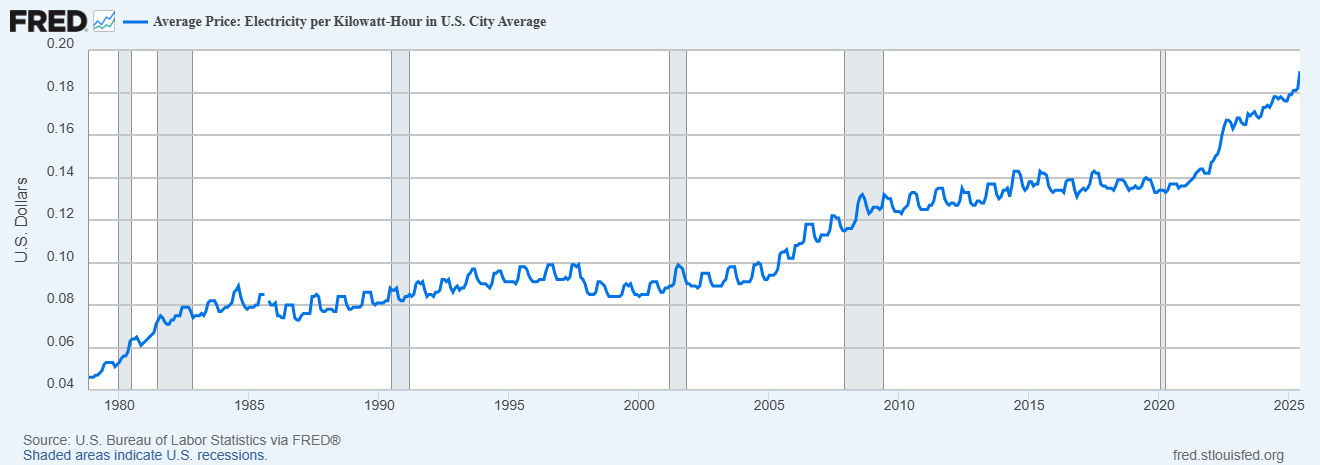
In addition to rising, many utility rate structures are changing. For example, many utilities are adopting time-of-use (TOU) rate plans in which the price of electricity fluctuates throughout the day and year based on demand. Typically, in these plans, rates are much higher in the summer and hit peak pricing in the evenings when electricity demand is at its highest.
Where are electricity prices rising the fastest?
The cost of electricity rises at varying speeds across the country, and even varies from utility to utility. In the last three years, electricity rates on the East and West Coasts have increased the fastest—although it’s worth noting that every region of the US has seen prices rise substantially.
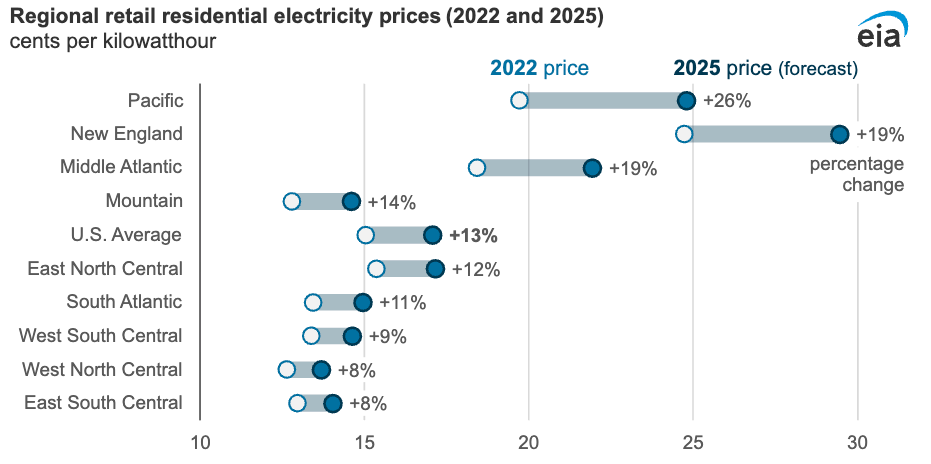
In 2025, 13 states in the Mid-Atlantic and Midwest saw significant rate hikes beginning on June 1, stemming from an 840% surge in pricing at latest the PJM Capacity Auction.
Homeowners in the following states are especially impacted:
| State | Expected Bill Increase to Average Bill |
| Ohio | 10-15%, depending on utility provider |
| Pennsylvania | 10-20%, depending on utility provider |
| Delaware | 7% statewide |
| Maryland | 2-24%, depending on utility provider |
| New Jersey | 17-20%, depending on utility provider |
| Washington DC | 10% bill increase for PEPCO customers |
| Illinois | $7.50 to $10 per month, ComEd customers only |
Now that we have a sense of what’s going on with utility electric rates, let’s look at some ways to diagnose the primary cause of your high electric bill and prevent it from happening again.
My electricity bill is too high. What can I do?
If your electricity bill is too high, the first thing to do is to diagnose the problem. Figure out why your bill is higher than expected. Is it due to a usage increase, rate increase, or both?
Spoiler alert: It’s usually a bit of both.
Fortunately, your best source of information – the electricity bill itself – is already right in your hands.
Identifying electricity rate hikes
Start by looking at your electricity rate. Has it gone up since last month or last year? How much?
To answer this, you’ll need to dig up two more electricity bills: One from the previous month and one from the same month of the previous year. So, if your high electricity bill came in September 2025, you’d want to dig up the bills from August 2025 and September 2024.
The bill from the previous month shows you any recent changes in your rate, while the bill from last year will show you changes from the most recent comparable billing period.
On these bills, you’re going to see a section that looks something like this:
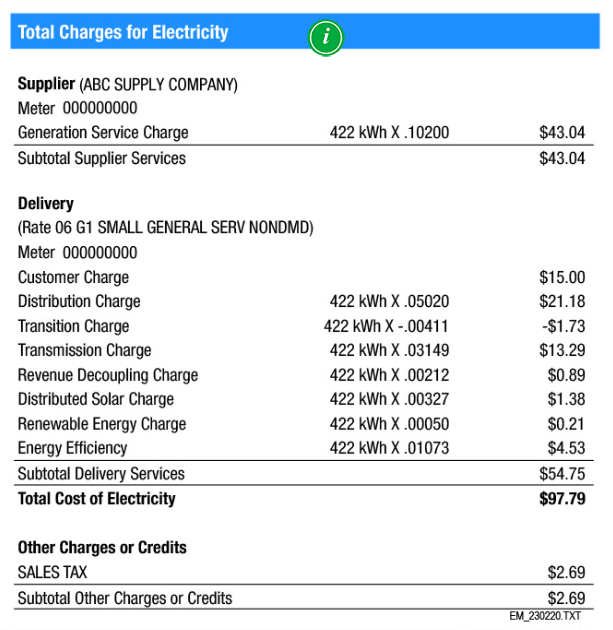
Now, there’s a lot going on here, but we’re interested in the set of decimals in the middle column just to the right of “422 kWh.” These decimals represent your electricity rate itemized into various service and delivery charges. To find your total electricity rate, simply add up all of the decimals.
In this case, they add up to $0.1962 or 19.62 cents per kWh.
Next, compare this rate with the rates for the previous month and year. Is it higher or lower? If so, by how much? You can find the percent change in your utility rate by following the formula below:
Percent change = (Current rate – Previous rate) / Previous rate x 100
Utility rates typically increase by 2-5% per year, depending on where you live. Any rate increase is worth noting, but increases above 5% — like we saw in 2022 — can do some serious damage do your monthly budget.
If your rates have increased substantially, then it may be time to search for a more affordable source of electricity, which we’ll discuss below. If the rate doesn’t seem to be the issue, then it’s time to look at your electricity usage.
Identifying changes in your electricity usage
In addition to rate hikes, spikes in your electricity consumption can lead to high electricity bills. Increased consumption is typically due to unseasonable temperatures that require additional heating or cooling. However, there’s an endless list of factors that can run up your monthly usage.
To see how your electricity usage has changed, it’s best to compare bills from the same month to get an accurate year-over-year comparison. So, if your high electricity bill comes in February 2025, compare your usage to February 2024 to account for the weather.
Fortunately, most utility bills already contain this information, like the sample bill below:
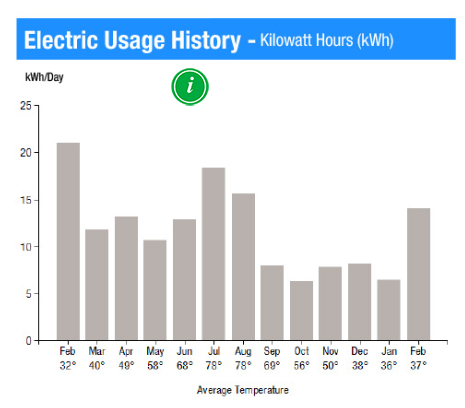
The chart above shows 13 months of average daily electricity usage. Why 13 months? So you can compare your current bill to the same month from last year.
In this example, consumption was down year-over-year by about 7 kWh per day. If your consumption is down and your electricity bill is high, then it’s definitely a rate issue. But if your consumption is up significantly year-over-year, then it’s time to ask why.
The chart above gives us a clue. In February 2023, the average temperature was 5 degrees warmer than February 2022, which presumably required this homeowner to use less electricity to heat their home. But if the answer isn’t so straightforward, there are some other culprits:
- New electric appliances and/or electric vehicle
- Working from home instead of going to an office
- New baby or person in the house consuming electricity
- A new hobby or pastime that uses substantial electricity (woodworking, gaming, baking, etc.)
If you can’t put your finger on it, consider undergoing an energy audit from your utility provider. This may help you identify excess electricity usage that’s running up your bill and ways to reduce your usage.
3 strategies for reducing electricity consumption
If you’re wondering, “Why is my electricity usage so high?” then it’s time to take a closer look at your electricity consumption habits. There are countless ways to reduce electricity consumption, but rather than rattle them off one by one, we’re grouping them into three strategies:
- Use less electricity
- Upgrade to more efficient systems
- Improve your home’s envelope
The first strategy is the easiest and quickest to deploy – although your kids won’t love it.
Use less electricity
Let’s be honest, Americans aren’t particularly great about conserving energy. In fact, many of us (myself included) tend to take electricity for granted until the power goes out or we get slapped in the face by a high electricity bill.
But before you start unplugging appliances and yelling at your spouse for leaving lights on, let’s take a second to evaluate where we can conserve a meaningful amount of electricity.
To do that, we’ll start with the question, “What uses the most electricity in a home?”
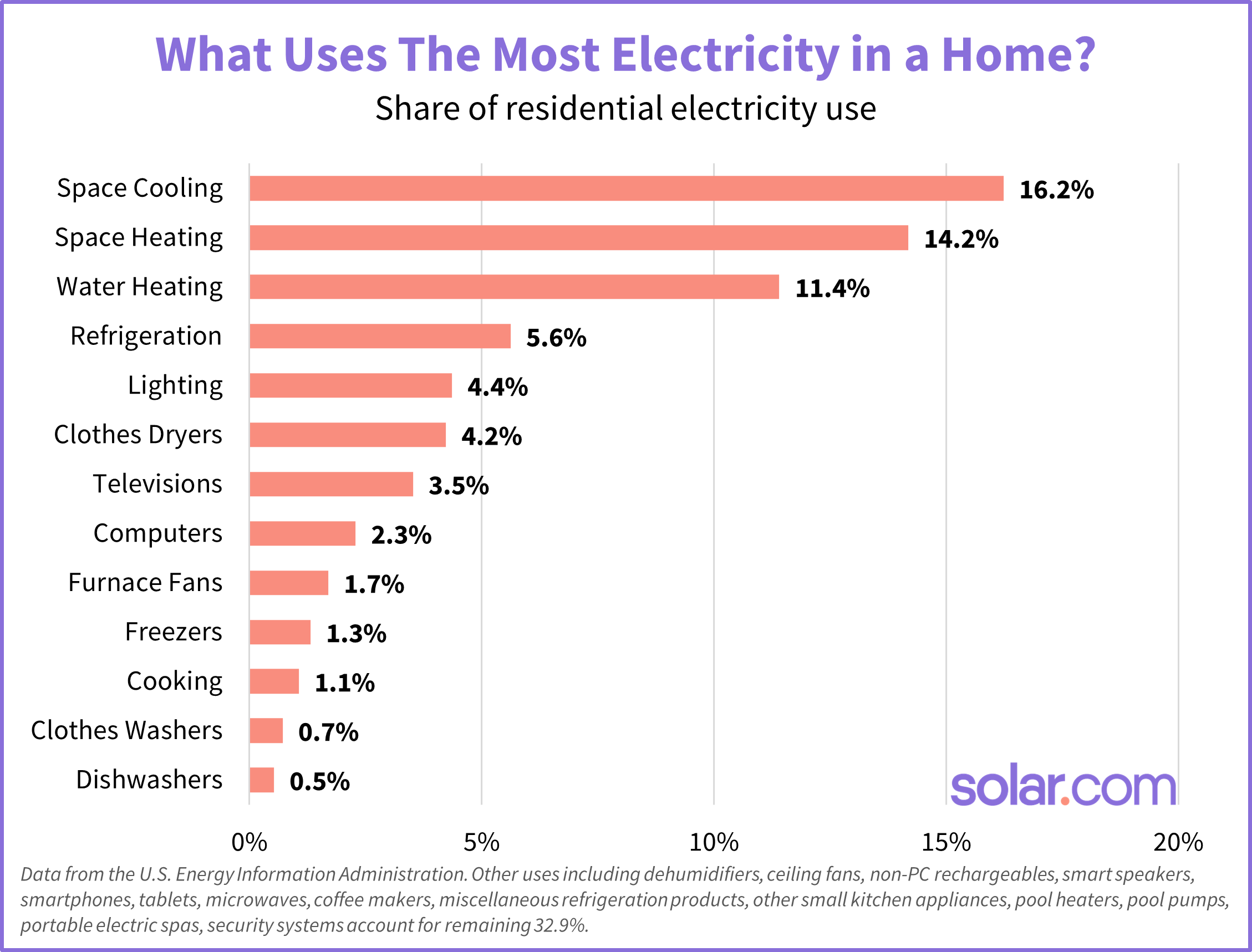
As shown in the chart above, space cooling, space heating, and water heating are in a class of their own when it comes to electricity consumption, and therefore present the biggest opportunity to save electricity and money.
Space heating and cooling conservation tips
Use a programmable thermostat to set your home temperature 7-10°F higher or lower for 8 hours a day. For example, if your house is typically 70 degrees in the winter, set the thermostat to 60-63°F while you are sleeping or at work.
According to the US Department of Energy, this strategy alone can save up to 10% on heating and cooling.
Set your thermostat as high or low as you can tolerate. The closer your home temperature is to the outdoor temperature, the less energy you’ll use. Exactly what that number is depends on your comfort level and savings goals. One trick is to gradually raise or lower the thermostat one degree every day to find your limit.
Water heater conservation tips
Lower the thermostat on your water heater to 120°F. Manufacturers often pre-set water heaters to 140°F which is hotter than most people are comfortable with anyway. Lowering the temperature gives your water heater a break and can reduce wear and tear.
Use less hot water. People tend to associate long showers and leaving the faucet running with water waste, but it’s also a waste of the energy used to heat that water. Here are a few opportunities to reduce your water heating costs:
- Take shorter and/or colder showers
- Use less water to fill the bathtub and/or take less frequent baths
- Turn off the faucet when you’re brushing your teeth and shaving
- Turn off the faucet between rinsing dishes (or use cold water)
- Don’t use hot water when colder water will do the trick
Other electricity conservation tips
Space and water heating present the biggest opportunities for savings, but it’s worth looking at other systems too. Some ideas include:
- Keeping your fridge and freezer two-thirds full and keep the doors closed as often as possible
- Set your fridge to 40°F and your freezer to 0°F (but not any warmer!)
- Shut off lights when you’re not using them or don’t need them
- Hang dry your clothes when possible
- Turn off TVs, computers, and other electronics when you’re not using them (and limit use in the first place)
Using less electricity is a good practice. However, these efforts can be undercut by things like the weather and the efficiency of your appliances. So, the next strategy is to upgrade to more efficient appliances.
Efficiency upgrades
You can fine-tune your thermostat all you want, but there’s only so much you can save if your heating and AC units are old, inefficient, or working improperly. So, the next strategy is to upgrade to energy-efficient appliances. These opportunities range from installing a new heat pump HVAC system to switching to LED light bulbs. But the bigger the system, the bigger the cost savings.
Fortunately, there are a number of rebates and tax credits in the Inflation Reduction Act (IRA) for energy efficiency upgrades. For example, the IRA created a $8,000 rebate and a tax credit worth up to $2,000 for heat pump HVAC systems.
*Note: Tax credits for energy efficiency upgrades were eliminated by the “One Big Beautiful Bill” and need to be installed by December 31, 2025 to qualify.
There are also incentives for:
- Heat pump water heaters
- Electrical panel upgrades
- Electrical wiring
- Electric stoves, cooktops, ovens, and ranges
- Heat pump clothes dryers
- Energy-efficient ACs and furnaces
Use this calculator from Rewiring America to find out which rebates and tax credits you qualify for.
It’s worth noting that replacing a gas appliance (like a gas furnace) with an electric appliance (like a heat pump) will increase your electricity consumption. However, electricity is cheaper than gas in most markets, and the new appliance will be much more energy and cost-efficient.
So, your electricity bill might go up, but it is typically more than offset by reductions in your gas bill.
Seal and insulate your home
The third energy savings strategy is improving your home envelope by sealing cracks and insulating walls to minimize leakage. Over 30% of your electricity goes towards heating and cooling, and it’s a crying shame to watch that expensive air literally slip through the seam in the wall.
There are a number of ways to create a tighter home envelope, these include:
- Caulking the seal around windows
- Properly insulate walls, basements, and attics
- Adding weather stripping to exterior doors
- Patch holes in interior and exterior walls
- Cap and/or plug unused chimneys
- Seal and insulate vents, pipes, and air ducts
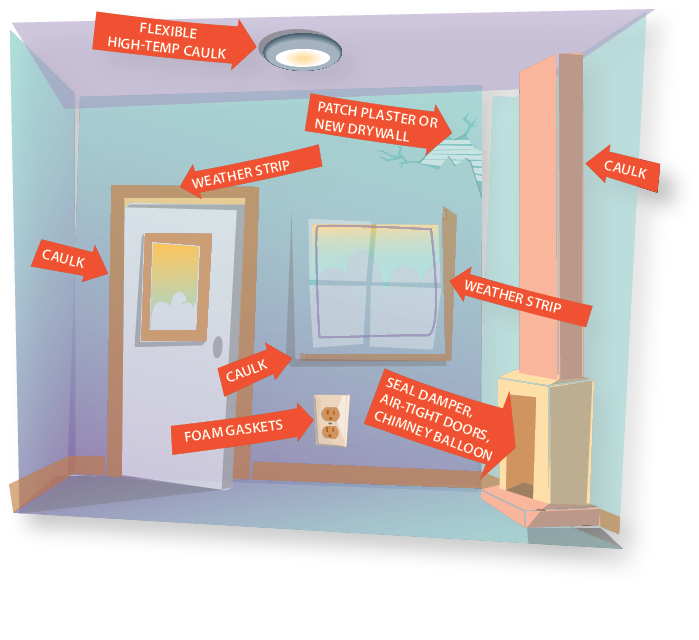
Many of these are simply DIY projects that can easily be done with instructions from YouTube. Others require professional help. Fortunately, the Inflation Reduction Act created incentives for the bigger projects, including:
- A rebate worth up to $1,600 for insulation, sealing, and ventilation equipment and installation
- A tax credit worth up to $600 per year for exterior doors and skylights
- A tax credit up to $150 for a home energy audit
*Note: Tax credits for energy efficiency upgrades were eliminated by the “One Big Beautiful Bill” and need to be completed by December 31, 2025 to qualify.
Of course, the best strategy for reducing your electricity consumption is a mixture of all three. Conserve as much as possible, upgrade when you can, and keep your home envelope as tight as possible.
But even all three of these strategies combined only tackle half of the cause of high electricity bills. Next, we’ll explore how to attack the other half: Your electricity rate.
How to reduce the price you pay for electricity
Even with the tightest home envelope and most efficient appliances, much of our electricity consumption is at the mercy of the weather, especially with climate change fueling more frequent and intense extreme weather events.
What you can control is how much you pay for electricity during these events.
The simple – and often overlooked – way to control your electricity costs is to install solar panels. Home solar is often pigeonholed solely as a way to reduce carbon emissions (which it absolutely does), but it’s also the most affordable and viable alternative to buying electricity from a utility provider.
It’s also a hedge against energy inflation in the form of utility rate hikes – which is half of the two-headed monster creating high electricity bills.
How does solar reduce your electricity bill?
In its simplest form, home solar is buying electricity in bulk at a much lower price per unit than grid electricity – not much different from buying coffee grounds at the grocery store instead of individual cups of coffee from a gas station (not even the good stuff from a coffee shop!).
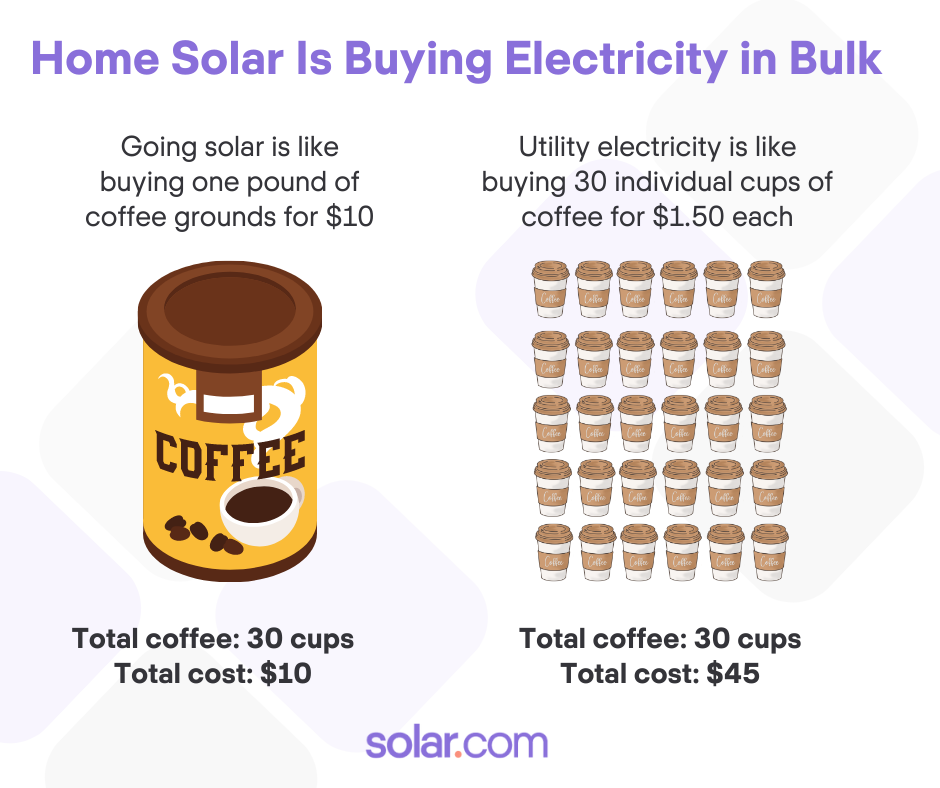
For example, in June 2025 the national average price for utility electricity was 19 cents per kilowatt-hour. Meanwhile, the average cost per kilowatt-hour for home solar is typically around 8 cents per kWh.
Here’s how the difference in rate translates into electricity costs:
| Electricity source | Monthly usage (kWh) | Price ($/kWh) | Monthly bill |
| Utility | 600 | 0.19 | $114 |
| Home solar | 600 | 0.08 | $48 |
Now, you can conserve all of the electricity you want, but you essentially have to go prehistoric to cut your usage in half. Remember, setting your thermostat up or down 7-10 degrees for 8 hours per day only achieves a 10% reduction, at most. But with solar, a 50% or greater reduction in the price you pay per kWh of electricity is very realistic, especially if you live in an area with above-average utility rates.
The other way to look at home solar is replacing your utility bill with lower monthly payments on your solar system. Those can be literal solar loan payments or they can be the price you paid in cash, theoretically spread out over the 25-year warrantied life of the system (300 months). Either way, through net metering or battery storage, you can all but eliminate your utility payments and save money by paying less for solar.
Regardless of how you picture it, home solar gives you something that a utility provider never will: Control over the price you pay for electricity
By having the final say in how big your system is, which equipment you use, which installer you work with, and how you finance your system, you are essentially controlling your electricity rate.
Hedging against energy inflation
The other important thing to remember is that the cost of utility electricity rises over time while the cost of a home solar system stays flat. This is similar to how buying a home gives you a flat mortgage payment for 30 years while renting leaves you exposed to rent increases.
For context, the national average price for electricity has increased 33 of the last 42 years and increased at an average rate of 2.8% per year during that time, as shown in the chart below.
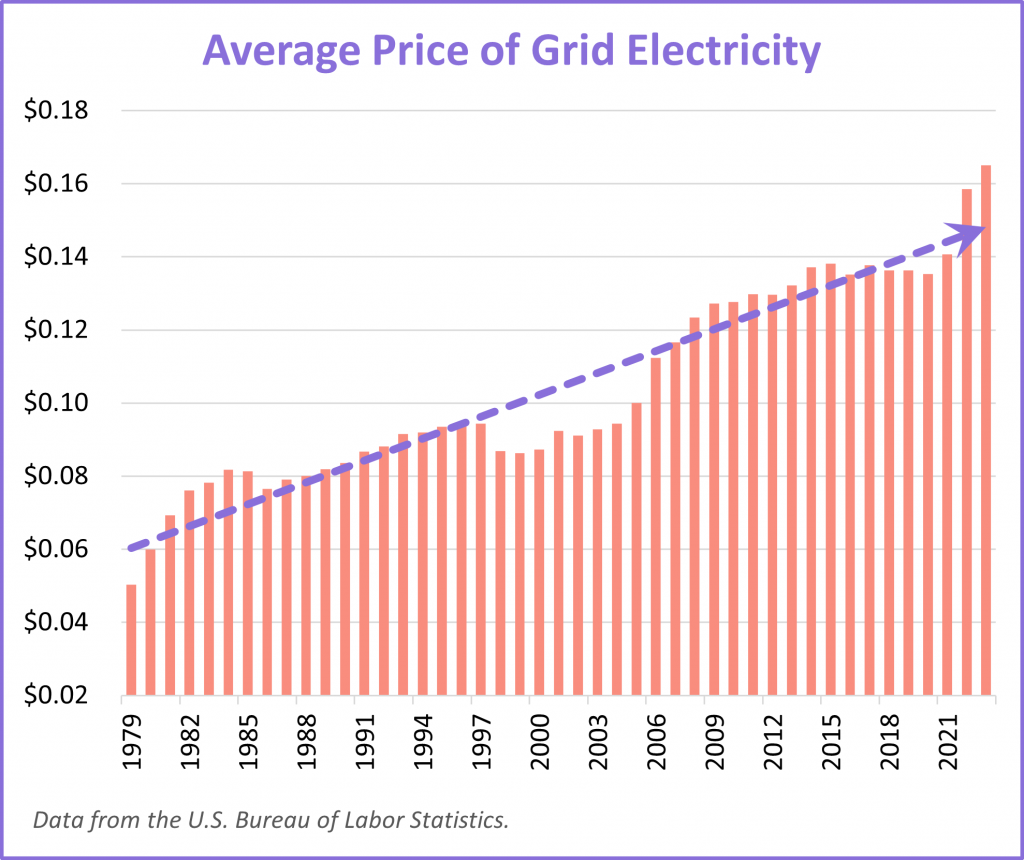
Meanwhile, the cost per watt of residential solar has plummeted over 50% since 2010.
By going solar, you put down your marker and say, “This is the price I’m paying for electricity for the next 25 years.” And instead of dreading utility rate hikes, you end up cheering for them because they fuel your solar savings.
The chart below shows the rising cost of utility electricity versus the flat cost of solar over 25 years. At the national average utility rate, most households can expect to save upwards of $35,000 over the 25-year warrantied life of a solar system, depending on how they finance the system. In states like California, New York, Massachusetts, and Connecticut, where the cost of electricity is upwards of 25 cents per kWh, homeowners can expect to save more in the short and long terms.
The pros and cons of home solar
Home solar is the most affordable and viable alternative to utility electricity. But just like every energy source, it has its pros and cons (see a more detailed breakdown here)
The pros of home solar include:
- Electricity cost savings
- Increased home value
- Reduced carbon emissions
- Control over your electricity rate
- Backup power during outages (if paired with battery storage)
- Setting a good example for your friends, neighbors, and family
The cons of home solar include:
- Need access to cash or financing to purchase a system
- Homes with shading are not suitable for solar
- Solar may require roofing or panel box upgrades
- Need battery storage or net metering to provide 24/7 power
- Solar requires more red tape than the average home project
Home solar isn’t for everyone, but it can be an extremely effective way to reduce your electricity costs and never have to worry about a high electricity bill again.
The bottom line
High electricity bills are becoming more common as household electricity usage increases alongside utility rates. The highest bills are typically a combination of both, often during summer months when air conditioning usage and utility rates are at their highest.
While most people focus on reducing their electricity consumption, it can be much more effective to focus on lowering your rate with a home solar system.
Solar doesn’t make sense for every home, but, when done right, can provide substantial long- and short-term energy cost savings and contribute to the clean energy transition.
Connect with an Energy Advisor to see how much you can lower your electricity bill with solar.



